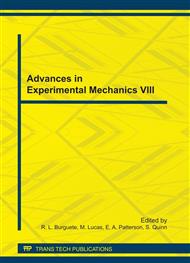p.428
p.434
p.440
p.446
p.452
p.458
p.464
p.470
p.476
Spectroscopic Birefringence Mapping by Channeled Spectrum
Abstract:
Birefringence mapping of objects has attracted great interest in the fields of material technology and biomedical science. This paper describes spectroscopic birefringence mapping using a channeled spectrum. To perform spectroscopic birefringence mapping using a microscope, an acousto-optical tunable filter (AOTF) was employed as a spectrometer. The AOTF can select a specific wavelength from a white light source. The optical arrangement consists of a white light source, the AOTF, a polarizer, two retarders with high-order retardance, two objective lenses, an analyzer, and a CCD camera. The polarizer and the first retarder can modulate the polarization state and they function as polarizing optics, while the second retarder and the analyzer can analyze the polarization state and they function as analyzing optics. A sample is inserted between the polarizing and analyzing optics. Images obtained at a specific wavelength generate 128 data points at visible wavelengths. A channeled spectrum (i.e., the intensity distribution) can be generated from the images obtained. A Fourier spectrum can be obtained by the fast Fourier transform (FFT) method. The birefringence properties of the sample can be derived by calculating the inverse FFT. We used this technique to measure the polarization properties of a nematic liquid crystal droplet.
Info:
Periodical:
Pages:
452-457
Citation:
Online since:
August 2011
Authors:
Price:
Сopyright:
© 2011 Trans Tech Publications Ltd. All Rights Reserved
Share:
Citation:


